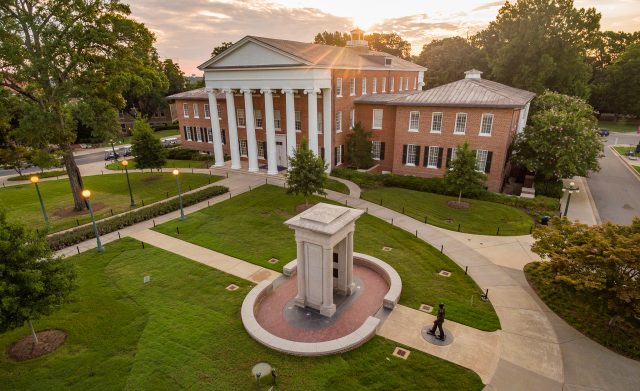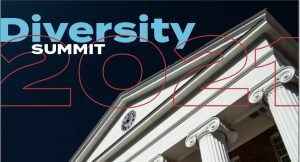
The university affirmed a commitment to strengthening a diverse and equitable learning and working environment with its Pathways to Equity strategic plan, released Jan. 22. Photo by Robert Jordan/Ole Miss Digital Imaging Services
OXFORD, Miss. – University of Mississippi officials shared the institutional commitment to strengthening a diverse and equitable learning and working environment Friday (Jan. 22) with the official launch of the university’s new Pathways to Equity strategic plan.
The plan was presented as a part of the Division of Diversity and Community Engagement‘s second Diversity Summit, which also featured a keynote from Gregory J. Vincent, professor and executive director of the Education and Civil Rights Initiative at the University of Kentucky, as well as a panel discussion between Vincent and UM diversity leaders.
“At the University of Mississippi, we are committed to being a place where all members of a diverse community can succeed,” Chancellor Glenn Boyce said. “Today’s summit and the unveiling of our new Pathways to Equity strategic plan are significant steps to help us strengthen and build upon this commitment.
“They will provide prominent ways for us to make positive and permanent change toward a more diverse campus that is welcoming to all.”
At the highest level, the plan’s goals are to advance the institutional capacity for equity, cultivate a diverse and equitable community, and foster an inclusive campus climate.
“The three overarching goals, coupled with individual college/school- and division-level Equity in Action Plans provide a road map for building on existing work, promoting inclusivity at all levels for all members of our community, advancing a more equitable environment and a better University of Mississippi,” said Shawnboda Mead, interim vice chancellor for diversity and community engagement. “We hope this plan leads to sustainable, high-impact change across the university.”
Boyce and Katrina Caldwell, inaugural vice chancellor for diversity and community engagement, began creating an institutional diversity, equity and inclusion plan in 2019. Mead has continued these efforts alongside the chancellor, culminating in Pathways to Equity.
“By taking this responsibility seriously and plotting a principled and measurable path forward, we also can play a role in setting an example for the nation and the world,” Provost Noel Wilkin said.
“This starts by engaging students who come to our institution and by showing that our institution, which once was the example of how people can stand in the way of equality, can be an example of equity, an example of inclusivity and a model of diversity.”

During the 2021 Diversity Summit, the Office of Diversity and Community Engagement unveiled the university’s new Pathways to Equity plan, which aims to create a more diverse and equitable learning and working environment.
In his keynote address, Vincent applauded the administration for its efforts to engage in the important work of creating diverse and equitable campuses. He spoke about the established legal duty of institutions of higher learning to create diverse learning environments.
“What the courts have established is that in order to pursue academic freedom and have a robust academic environment, you have to intentionally engage in diversity and have a diverse student body and faculty,” Vincent said. “What you have done today is reaffirm these principles.”
Vincent serves as an ongoing adviser to the university in the development of the Pathways to Equity plan. After acknowledging the efforts and commitment of the university’s leadership, he addressed the students, faculty and staff in attendance: “Now the hard work begins.”
To ensure the university’s overarching diversity, equity and inclusion goals are met, each campus academic and administrative unit has a designated diversity liaison and is charged with establishing three to five “Equity-in-Action” items, with metrics to be tracked for ongoing reporting and progress measurement. Liaisons have access to a diversity dashboard where demographics are tracked and action items can be measured.
Mead said she hopes these action items help achieve meaningful results and serve as accountability measures for this important work.
Vincent’s address was followed by a panel discussion with university leaders, including Kirsten Dellinger, associate dean for diversity and inclusion; Arthur Doctor, director of fraternity and sorority life; Susan Duncan, dean of the School of Law; Amy Fisher, associate professor of social work; Murrell Godfrey, assistant dean of diversity, equity and inclusion in the Graduate School; Annette Kluck, dean of the Graduate School; and Joshua Mannery, Associated Student Body president.
During breakout sessions, summit attendees heard updates from the Pay Equity working group and Campus Climate working group, as well as a preview of the Teaching for Inclusion workshop series. These sessions included smaller discussion groups in which attendees could ask questions and provide feedback.
To close, Mead reiterated the living nature of the strategic plan and asked that everyone provide feedback for ongoing improvement. She stressed the importance of community involvement because the plan is designed to be a collaborative, coordinated and proactive effort across the entire university community.
“So many individuals have come before me and have continued to advance diversity, equity, inclusion and anti-racism work on our campus,” Mead said. “We wouldn’t be here today, sharing in this moment without their efforts.”
Finally, she acknowledged the challenging and ambitious nature of the goals laid out in the plan, but said they are attainable as long as the university works as a community to meet them.
The Pathways to Equity plan can be found here.